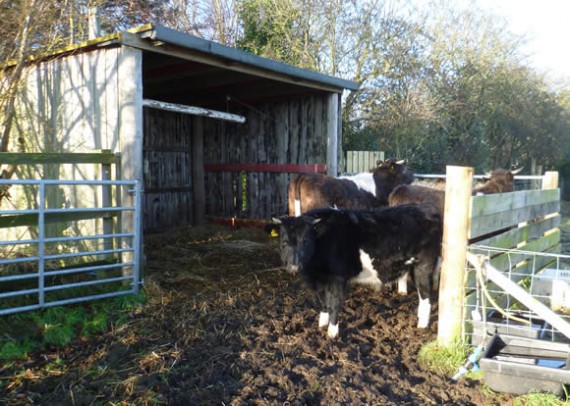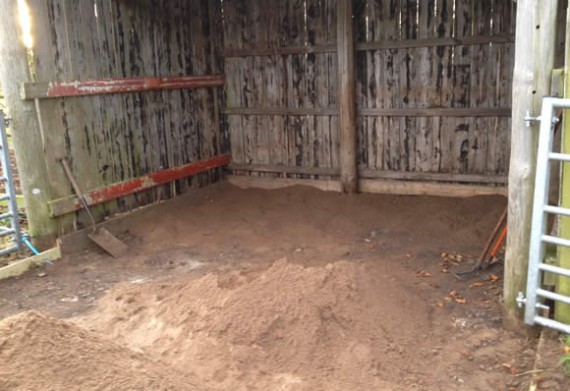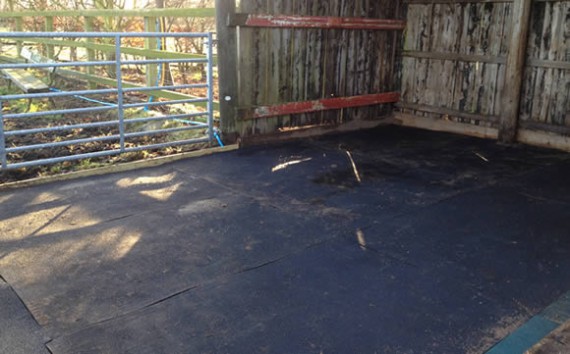Posted: Sunday 16 December, 2012
When we moved to Dalmore, there was a good field shelter built in the middle of the west boundary of the five-acre field, facing east. Constructed with telegraph poles and substantial boarding, with a packed earth floor, it was well worth keeping.
When we decided to split the five-acre field into two, we wanted to be able to make best use of the shelter so the dividing fence starts at the field shelter. To allow the shelter to be used from both paddocks and to give a bit of shelter from the east, we constructed a pen around the shelter, with a gate on each side.
The pen works well; both gates can be opened and closed to give access from either or both paddocks and livestock can be shut in the shelter, either with the outside area or not.
Last winter, I used it for haying the cattle and for keeping them in while I fed the sheep, as they were grazing together for a while. However, during this time, the shortcomings of the floor became apparent. Even with our sandy soil, the outside pen area became a muddy mess, full of trodden-in hay, faeces and mud. Any hay dropped was immediately lost.
 Mucky floored field shelter.
Mucky floored field shelter.
So this year, we decided to have a concrete floor laid, covering the whole area of the shelter and the pen, some 6m x 4.3m. As the summer wore on, the contractor was coming, but never actually getting here. A second contractor thought it would be difficult to get the concrete over the field (to be honest, we thought it would be difficult too â�º). Then we had a brainwave – at least, I hope it will turn out to be a brainwave, but time will tell.
Instead of concrete, we had the area dug out and filled with, well, rubble, I suppose. But Scott had a machine that crushes it and once it’s whacked, it’s pretty solid.
Boards have been put in round the edges and we’ve overlaid it with two tonnes of sharp sand in a layer about 2” deep.
 Spreading the sand floor.
Spreading the sand floor.
On top of that, we’ve put rubber cow matting from a company called Quattro. Each mat is 6ft x 4ft and weighs 45kg, so they are pretty robust as well as non-absorbent, have a non-slip top surface and a ridged base for drainage. The mats are more flexible than I expected, so it shouldn’t matter that the sand surface isn’t perfectly level. Now, with our usual skills in measuring, we were a mat short but there were some bits of green horse mats spare, so they’ve been cut to fill in the gaps.
 Completed floor.
Completed floor.
I’ve used rubber mats for the ponies for years and I think they find them quite comfortable to lie on, so I’m hoping that these ones will work as well in the shelter for whatever animals have access. And they are easy to keep clean, without using a lot of bedding. I haven’t quite decided what to do about bedding yet – options are straw, Hemcore or sand.
It’s quite a big investment for us but it should give us a much more versatile, useable space, especially over the winter period.
- Previous « Nemo's been a busy boy
- Next Revisiting the feed store »
Comments
Comments are now closed for this post.












Pedwardine
Wednesday 19 December, 2012 at 11:15pm
Would like to know how that works out. We had those rubber mats in our donkeys mobile shelter but directly on top of earth. Found it hard to scrape back soiled bedding with all those pesky bobbles. When it came to lifting them it was mucho stinko underneath with all the pee etc that had worked it's way through the joins. Hopefully your prep underneath should serve you well. Hmmm curious...